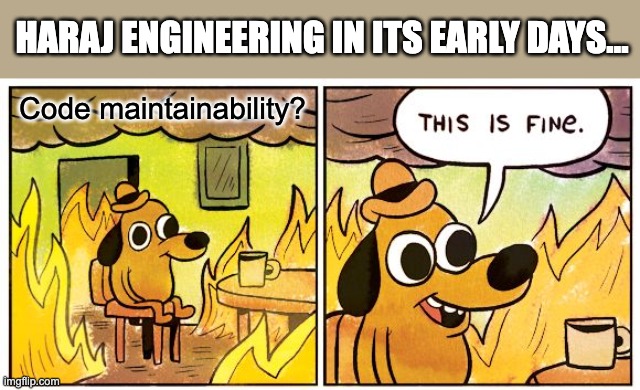Hex Monscape 👾
Hex-Monscape is a simple turn-based game created for Haraj Solutions Team onboarding process.
In the game source code, you can find the team's secret technique in writing production code for Haraj services that help serve millions of users daily in Saudi Arabia despite only having a handful of team members. 🥷🏻💥
The secret technique actually lies in the software architecture we choose for these services: Hexagonal Architecture.
In this repo, we use this remarkable architecture to structure Hex Monscape server code while implementing it using Golang. For the web client, we implement it using Vue 3.
To get started on how we apply Hexagonal Architecture to this game, please refer to this doc.
To start playing the game, please refer to How to Run The Game section.
Note:
Many people got interested in software engineering because of games, so using games as a medium for transferring knowledge to our team members might be a fun idea. This is why we created this project. 😃
Even though we are using Golang to implement Hexagonal Architecture in this repo, the architecture itself is language agnostic. So we can also apply it to other languages such as PHP, Typescript, & Python.
Background Story
One of the most significant engineering issues in Haraj is code maintainability.
What is code maintainability? It is the ability of a codebase to be easily maintained by other developers. So when a developer can no longer maintain the codebase, other developers could easily take over the code they left behind.
As you may already know, Haraj engineering team is relatively small. So in our early days, we gave project ownership to the developer who started the project. This developer will be responsible for every aspect of the project: writing the code, deploying it to production, & maintaining it.
At that time, we did not set up common standards for writing code for those projects. So every developer writes code based on their style & preferences with almost no consideration for other developers.
Usually, our developers will stay for quite a long time (~5 years) before they leave. So when a developer leaves the team, they usually own several valuable projects for Haraj business. The problem is that since the projects were written in the developer's style, no one in the team could easily take over those projects. 😅
This is why code maintainability grows into such a big issue in Haraj, and the solution to prevent more of this is to set up common standards on how to write code in Haraj projects. This is where Hexagonal Architecture comes into play.
Game Design
In the game you will play as a 10 years old monster hunter that dreams to become the very best. In order to reach that, you need to make journey together with your monster partner to seek 3 strong wild monsters and kick them in the butt. 💥💪🏻
The game scenario is pretty simple, player just need to choose monster partner then won battle for 3 times to beat the game. After that player may choose to end the game or continue playing.
Here is the flowchart for the game scenario:
Here is the flowchart for each battle in the game:
To see the REST API specification for this game, please see this doc.
How to Run The Game
You can try out this game online by visiting this URL: https://hex-monscape.haraj.app.
If you want to run the game locally, make sure following applications already installed in your machine:
- Docker
v20.10.23or above => this will also install Docker Composev2.15.1 - make => to execute the scripts for running the project defined in Makefile
After that use this command to run the game:
> make runWait for a moment until you see message like this:
rest-memory-client-1 | yarn run v1.22.19
rest-memory-client-1 | $ vite --host --port 8161
rest-memory-client-1 |
rest-memory-client-1 | vite v2.8.4 dev server running at:
rest-memory-client-1 |
rest-memory-client-1 | > Local: http://localhost:8161/
rest-memory-client-1 | > Network: http://172.31.0.3:8161/
rest-memory-client-1 |
rest-memory-client-1 | ready in 151ms.After that you could access the game by visiting this URL: http://localhost:8161.
Multiple Server Variants
Actually there are 3 variants of game server in this project:
- Server using In-Memory storage => run command:
make run-rest-memory - Server using DynamoDB storage => run command:
make run-rest-dynamodb - Server using MySQL storage => run command:
make run-rest-mysql
All of them serve the same game, the only difference is the place where they store the game data.
For details on these commands, please refer to this Makefile.
Note:
When we use Hexagonal Architecture to build an application, it is quite easy to swap its infrastructure code with another technologies.
So for example, if initially we used in-memory storage to store our data, we could easily swap it with MySQL storage or something else. This is why in this project we provide
3variants of game server for you, this is to demonstrate exactly this point.
Attribution
The monster characters used in this project is designed by Freepik. To be exact we are using this asset.
The memes used in this project is generated using this meme generator.
The project layout used in this project is inspired by this repo.
The font used in the words "Hex Monscape" on the Hex Monscape logo is Lexend Deca from Google Fonts.
Contributing
Got more idea on how to make this learning project more fun? Or maybe you found something that can be improved from this project?
Feel free to contribute to this repo by opening issue or creating a pull request! 😃
Core Maintainers
Got any questions related to this project? Feel free to contact us:
- Riandy Rahman Nugraha (@riandyrn)
- Muhammad Iskandar Dzulqornain (@isdzulqor)
- Muhammad Izzuddin al Fikri (@knightazura)
- Alfat Saputra Harun (@harunalfat)
- Ilham Syahid Syamsudin (@ilhamsyahids)
We will be very happy to help you! 🚀
License
MIT

